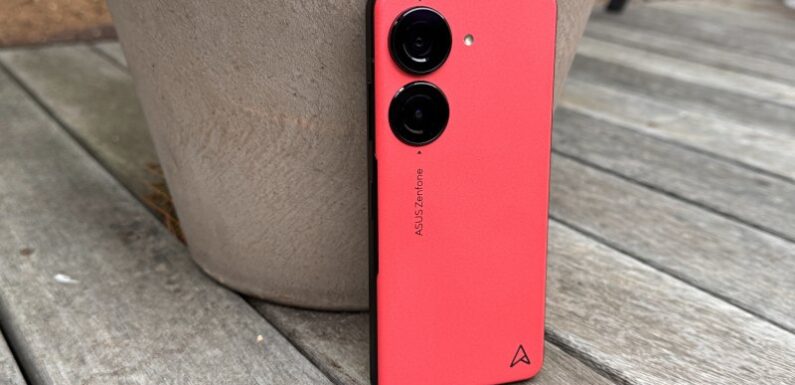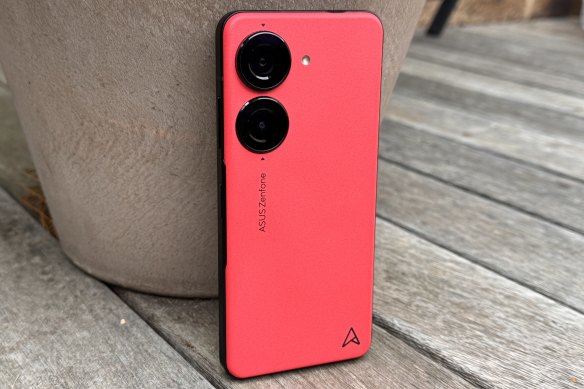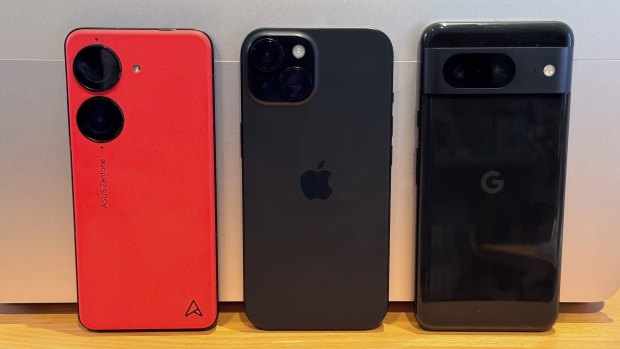
Save articles for later
Add articles to your saved list and come back to them any time.
As anyone who’s looked for a high-end smartphone you can use with one hand will know, devices have been trending larger for a while. The biggest new phones aren’t as gigantically large as they once were, but there also aren’t any new options for users who like a more pocketable size.
There are small phones available in the budget space (not as many as there used to be), but if you want power, features and compatibility in a small package, the pickings are extraordinarily slim.
The Zenfone 10 is a new smartphone that ASUS claims is more pocketable than the competition.Credit: Tim Biggs
The best small phones of 2023
Apple no longer makes an iPhone Mini, which at 132 millimetres tall was by far the smallest of high-end phones released in 2020 and 2021. But given a lack of competition in the space, its current iPhone 15 ($1500) and iPhone 15 Pro ($1850) still rank among the shortest at 148mm.
Given the 15 Pro’s incredible display, processor and cameras, it’s not difficult to name it the best small phone of 2023, but it’s also easily the most expensive.
On the Android side, the Samsung Galaxy S23 ($1450) at 146mm tall, and Google Pixel 8 ($1200) at 151mm are also among the shortest high-end devices. Choosing between them is a matter of higher price, more raw power and extra cameras on the Galaxy, greater simplicity and useful AI on the Pixel. Both of them reserve more advanced features for their more expensive siblings, which are also significantly bigger.
The Zenfone 10 next to the iPhone 15 and Pixel 8.Credit: Tim Biggs
The most recent compact release is the ASUS Zenfone 10, which deserves special attention as it is practically the only phone released this year boasting about its modest size as a desirable feature. It is narrower than 70mm, and has a display smaller than 6 inches, which makes it littler than all the above phones. But just barely.
At a glance, the Zenfone does look smaller, but some of that is styling; it has large black rings around its cameras and a black frame around its brightly coloured curved back. The tape measure doesn’t lie though; the Zenfone is barely a millimetre shorter than the iPhone 15, and it’s a couple of millimetres thicker. It is, however, narrower across by around three millimetres. I can easily wrap my hand around it and touch my thumb and middle finger together, which is a stretch on the iPhone.
The Zenfone 10 is also an excellent phone, with a great looking, high refresh screen; a roughly textured plastic finish; a powerful and brand new Snapdragon 8 Gen 2 processor; and all the details you expect in 2023 (fingerprint reader, waterproofing, wireless charging) as well as an honest-to-goodness 3.5mm headphone jack.
Compared with Google’s Pixel 8, it’s more powerful and a touch more expensive at $1300. It can’t quite measure up in terms of cameras and software, but by no means does a bad job. Yet to claim that its smallness is a major distinguishing feature might be a bit of an exaggeration – it’s around 4mm shorter and 2mm narrower.
Why don’t companies make truly smaller phones?
It’s common to see people online claiming to want a smaller, high-end phone. In 2020, Apple gave it to them in the form of the iPhone 12 Mini, with its titchy 5.4-inch screen. It followed that up with an iPhone 13 Mini. But a year later it ditched the idea – and last month is stopped selling the 13 Mini entirely.
This would likely indicate that there just weren’t enough people who wanted a brand new diminutive phone – at least not an Apple one – and that the company couldn’t justify making them.
Essentially, all other companies are beholden to the industry trends. You can’t simply call up Samsung Display and ask for a small order of OLED panels in a size nobody else is making. Besides, stuffing increasingly more powerful processors, bigger cameras and higher capacity batteries into high-end devices isn’t conducive to small frames.
A group of designers calling themselves the Small Android Phone team – several of them having worked on the Pebble smartwatch, which was eventually bought by Fitbit – began talking publicly this year about making a little device. But discussing the process with followers on Discord, they’ve identified the display as a tricky piece of the puzzle.
Manufacturers don’t make displays under 6 inches available for purchase, with special cases (such as the iPhone Mini) being made under exclusive contracts. The best lead they have so far is to try to use displays designed for the front part of a foldable phone, but they’re yet to strike an agreement.
What are my non-2023 options?
If you want a high-end small phone, your only course of action is to buy something from several years ago. This means accepting you may not get as many years of operating system upgrades (or battery life) as you would with something brand new, and won’t get the very latest processors or features.
For Apple, the iPhone 13 Mini is the obvious choice. The A15 processor is still very snappy, the screen and cameras are great, and it’s legitimately small; even shorter than the iPhone 6 Apple was selling in 2014.
Things are more difficult in Android land. I love the small and inexpensive Pixel 5, but at more than three years old now, it can be hard to find. With its recent update to Android 14, it’s also at the end of its guaranteed update window. All more recent Pixels are at least half a centimetre taller, but it could be worth it for a more future-proof device.
Get news and reviews on technology, gadgets and gaming in our Technology newsletter every Friday. Sign up here.
Most Viewed in Technology
From our partners
Source: Read Full Article

